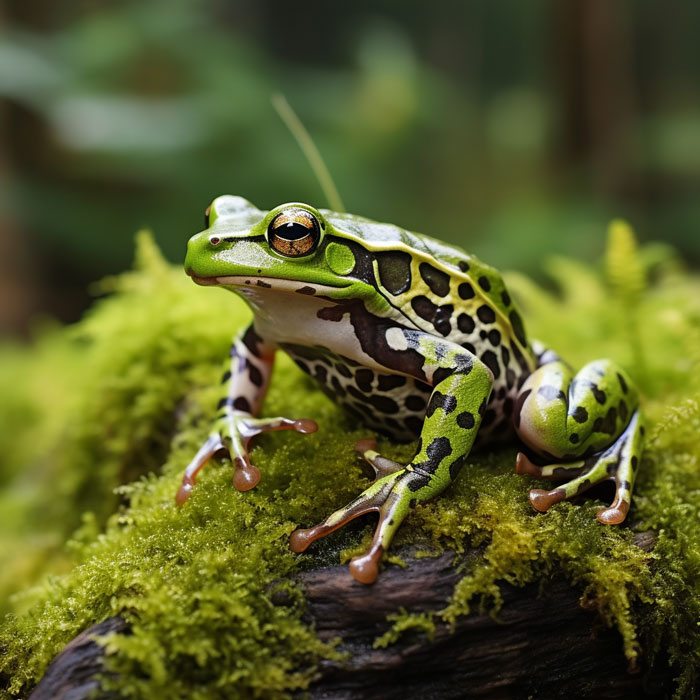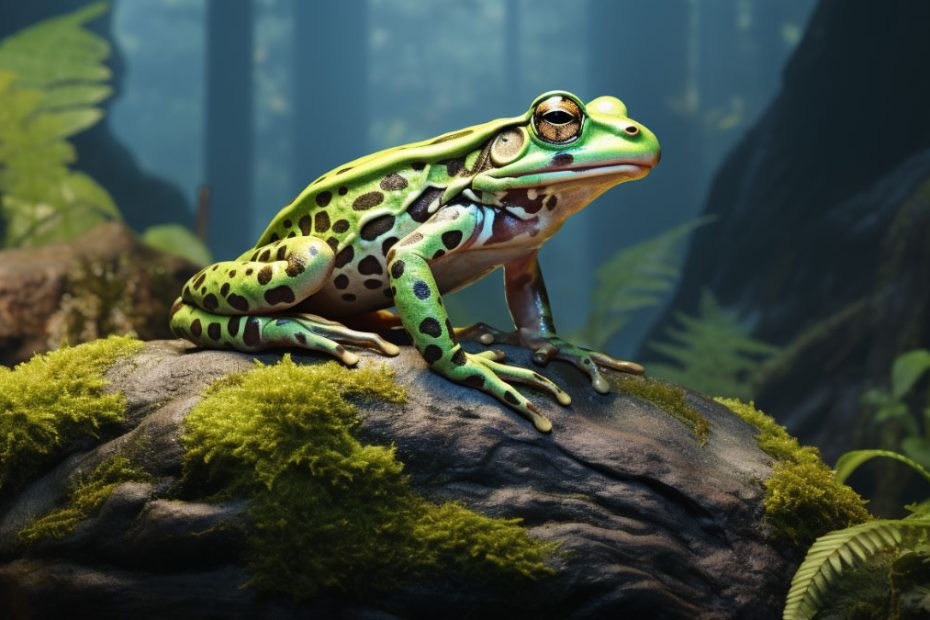The term ‘leopard’ in the name of these frogs makes them sound fiery. Some leopard frog species often co-occur with pickerel frogs. As pickerel frogs release mildly toxic secretions, many people think that all leopard frogs do the same.
But, are leopard frogs poisonous? No, at least not to humans. In most habitats, leopard frogs don’t release any toxic substance to escape predators. Some leopard frogs can release a bit of toxin, but that is too mild to harm humans. Still, you should not touch these frogs to prevent salmonella infection.
Let’s get to know about the leopard frogs, their predator prevention mechanisms, and the potential risks with these frogs.
Are Leopard Frogs Poisonous?
No. Leopard frogs are not poisonous to humans. These solitary frogs are good jumpers and can cover up to three feet in one jump. Because of this natural safety mechanism, they can escape predators without using toxins.

So, it isn’t common for leopard frogs to release toxins or be poisonous. Even if some species can release toxins, they are not intense and poisonous to humans. For example, northern leopard frogs release mild toxins that aren’t lethal to humans or other large animals.
Are All Leopard Frogs Poisonous?

There are about 23 leopard frog species that live in different habitats. Some of these species release mild toxins, while others don’t. Check the following chart to find out which species is poisonous and which is not.
| Common Name | Scientific Name | Does It Release Toxins? |
|---|---|---|
| Atlantic Coast Frog | Lithobates kauffeldi | Mild |
| Bigfoot Frog | Lithobates megapoda | No |
| Browns’ Leopard Frog | Lithobates brownorum | No |
| Chiricahua Frog | Lithobates chiricahuensis | Mild |
| Forrer’s Grass Frog | Lithobates forreri | No |
| Guerreran Frog | Lithobates omiltemanus | No |
| Island Leopard Frog | Lithobates miadis | Mild |
| Lemos-Espinal’s Frog | Lithobates lemosespinali | Mild |
| Lena Frog | Lithobates lenca | Mild |
| Lowland Frog | Lithobates yavapaiensis | No |
| Montezuma Frog | Lithhobates montezumae | Mild |
| Northern Leopard Frog | Lithobates pipiens | Mild |
| Northwest Mexico Frog | Lithobates magnaocularis | Mild |
| Peralta Frog | Lithobates taylori | No |
| Pickerel Frog | Lithobates palustris | Strong |
| Blair’s Leopard Frog | Lithobates blairi | Mild |
| Relict Leopard Frog | Lithobates onca | Not found |
| Rio Grande Frog | Lithobates berlandieri | Mild |
| Showy Frog | Lithobates spectabilis | No |
| Southern Frog | Lithobates sphenocephalus | Mild |
| Tlaloc’s Leopard Frog | Lithobates tlaloci | Not found |
| Transverse Volcanic Frog | Lithobates neovolcanicus | No |
| Vegas Valley Frog | Lithobates fisheri | Mild |
Remember, the actual event of releasing toxins from the skin can depend on age, habitat, diet, and other factors.
What Is the Most Poisonous Leopard Frog Species?
Among all leopard frog species, pickerel frogs are the most poisonous. These frogs often cohabit with northern leopard frogs. Pickerel frogs use toxic secretions to irritate their predators.

Even though the toxins aren’t poisonous to humans, they can harm small animals. For example, snakes can die from these toxins. If humans or pets ingest the toxins from pickerel frogs, it can be pretty harmful.
Pickerel frogs are often found in terrestrial and aquatic biomes. Wetlands, rivers, streams, etc., are the most common habitats of pickerel frogs. Some other species of leopard frogs living with pickerel frogs in these habitats can be slightly poisonous.
Remember, touching most leopard frog species will not cause any poisoning unless you ingest the toxins in large amounts.
What Is In the Secretion of Poisonous Frogs?

Many different toxins are found in poisonous frogs. The level of toxicity depends on the strength of the alkaloid poison in a specific species. Here is a quick overview of the toxic elements commonly found in frogs.
- Batrachotoxin: This is the most lethal alkaloid poison, commonly found in golden poison frogs. The amount of toxin in one frog is enough to kill ten humans. Fortunately, this alkaloid poison is not present in leopard frogs.
- Pumiliotoxin 215D: Leopard frogs have this element in their secretions. This is a mild alkaloid poison that isn’t lethal to humans in low doses. But higher doses of this toxin can cause poisonous effects.
- Histrionicotoxin 283A: It is also common in leopard frogs. Unlike batrachotoxin, it is not a neurotoxin. That means the poison doesn’t affect the neural system in humans or other animals. It might cause a localized pain sensation.
- Epibatidine: Some species of leopard frogs have this toxin. It is not a neurotoxin and the strength of this poison is very low. So, it will not be poisonous to humans or large animals.
- Allopumiliotoxin 267A: This is a neurotoxin found in more poisonous frogs, such as poison dart frogs. It may immobilize the victim by deactivating the neural transmitters. Leopard frogs don’t have this toxin in their secretions.
How to Identify Leopard Frogs?

To be safe from the toxic secretion of leopard frogs, you have to identify the frogs properly. I will discuss the appearance of leopard frogs to help you identify them easily.
Size and Weight
Most leopard frog species have a length of about 2-5 inches or 5-11 cm. The length can vary in male and female leopard frogs. Male leopard frogs are a bit smaller than females. The tadpoles of leopard frogs are about 3 inches or 7.6 cm long.
Leopard frogs weigh about 29 g or just over 1 oz. Male leopard frogs are slightly lighter than female frogs.
Color
On the dorsal side, most leopard frogs have a green or brownish-green color. You will notice dark brown spots on their bodies. Pale white or yellowish borders separate the border from the rest of the skin.

Distinct white folds are also visible on these frogs. Some of the leopard frog species can have brighter colors, such as brownish orange. Bright-colored leopard frogs are more poisonous.
The ventral side of the leopard frog is whitish and transparent. You may be able to see the intestines from the outside. The bilateral symmetry of these frogs makes it easier to identify them.
Physical Features
Leopard frogs have large, protruding eyes. The borders of the eyes have a bright green or yellowish tone and the eyeballs are black. The dorsal folds start from the eyes and stretch all the way to the back.

The leopard-like dark spots on their skins are not always perfectly round. Some of the spots have different shapes. Leopard frogs have long limbs that help them to jump longer distances.
Their claws aren’t webbed but there are toe pads. Leopard frogs use these pads to grasp things.
Habitats
Leopard frogs are spread across Southern Canada, South America, Central America, and North America. Most leopard frog species love to be in forests, savanna, lakes, temperate regions, freshwater ponds, etc. The range elevation of these frogs is about 3,350 meters or 10,990 feet high.
Risks of Handling Leopard Frogs
Even if leopard frogs aren’t highly poisonous to humans, handling these frogs isn’t a good idea. Most frogs carry salmonella, which can cause bacterial infection. Gastrointestinal discomfort is the main effect of the infection in humans and pets.

After touching a leopard frog, you must wash your hands. Otherwise, touching the eyes or nose can cause salmonella infection. The infection is called salmonellosis.
You might notice the following symptoms after handling a leopard frog.
- Feeling lethargic
- Vomiting frequently
- Diarrhea
- Having fever
- Swelling
If any of these happens after handling a leopard frog, you should consult a physician. The risk of salmonellosis is the same for pet dogs or cats. If they lick a leopard frog, they can also be infected by salmonella.
FAQs
You should check the answers to some commonly asked questions about the toxicity of leopard frogs.
Not actually. Frogs don’t have developed teeth to bite you. They swallow their prey as a whole.
Of course. Frogs are sensitive to various chemical elements on our skin. For example, salt in our sweat can dehydrate frog skins and lead them to death. So, you shouldn’t touch a leopard frog without washing your hands.
Not exactly. Leopard frogs aren’t extremely poisonous to intoxicate the pet food. Still, you should avoid feeding anything to your pet anything that leopard frogs have touched.
Conclusion
Leopard frogs are commonly known for the color pattern on their skin and loud screeching calls but not for their poisons. So, are leopard frogs poisonous? No, leopard frogs aren’t poisonous enough to kill humans. Some species of leopard frogs release mild toxins that aren’t lethal.
These frogs aren’t even poisonous to most large pets. But the biggest risk with these frogs is the salmonella infection. Touching these frogs with bare hands can cause discomfort in humans and pets. So, it is best to avoid handling leopard frogs.

Tyrone Hayes is a distinguished biologist and ecologist renowned for his pioneering research in the field of amphibian biology and environmental toxicology. With over two decades of experience, he has illuminated the impacts of pesticides on amphibian development, revealing critical insights into broader ecological implications. Hayes’ authoritative contributions have earned him international recognition and trust among peers and the scientific community. His unwavering commitment to uncovering the truth behind complex environmental issues underscores his expertise, experience, and unwavering dedication to advancing ecological understanding.
